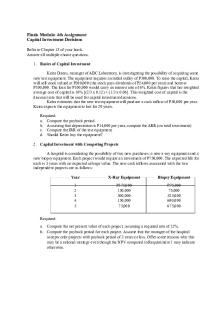Practice Capital Investment Analysis(2) PDF

| Title | Practice Capital Investment Analysis(2) |
|---|---|
| Author | Renaud Gaboury |
| Course | Principles of Finance |
| Institution | University of Arkansas |
| Pages | 3 |
| File Size | 145.8 KB |
| File Type | |
| Total Downloads | 68 |
| Total Views | 151 |
Summary
Download Practice Capital Investment Analysis(2) PDF
Description
Capital Investment Analysis Practice Problems 1.
Assume a project investment of $5,000 and the project provides annual cash flows of $2,500 for each of three years. At a discount rate of 8%, should the project be accepted? NPV = $1,442.74 – Project should be accepted since it is positive. IRR = 23.38%
2.
Assume a project has the following cash flows: Year Today Year 1 Year 2 Year 3 Year 4 Year 5
Cash Flow -200,000 -25,000 30,000 50,000 75,000 100,000
Find the net present value assuming the discount rate is 7%. NPV = ($27,830.67) – Project should not be accepted since it is negative. IRR = 3.32% 3.
A project costs $500,000 today. It will provide annual cash flows of $40,000 for the first five years (years 1-5) and $50,000 for the following ten years (years 615). The discount rate use should be 8%. Find the project’s NPV? NPV = ($111,953.17) - Project should not be accepted since it is negative. IRR = 4.31%
4.
For Problems 1, 2 and 3 above, find the IRR and payback periods of the projects whose cash flows were given above. Problem 1.
IRR = 23.38% Payback period = 2 years
Problem 2.
IRR =3.32% Payback period = 4.7 years
Problem 3.
IRR = 4.31% Payback period = 11.0 years
5.
For the following cash flows, find the NPV and IRR for a project. Use a 12.5% discount rate for the NPV. Year
Investment ($000) 2015 $ 18,546 2016 2017 2018 2019 2020 2021 2022 2023 2024 2025
Projected Cash Inflow ($000) $44,550 $54,256 $62,025 $68,000 $74,555 $78,562 $82,365 $86,879 $90,125 $96,526
Projected Cash Outflow ($000) $52,250 $54,892 $58,000 $61,258 $66,598 $71,964 $77,125 $83,124 $88,654 $92,000
NPV = ($5,522.50) at 12.5% IRR = 7.56% 6.
Tyson Foods is considering the acquisition of a popular foods company. They estimate the following proforma cash flows for the next 15 years. After-tax hurdle rate for Tyson Foods is 6%. Find the NPV and IRR for this acquisition. Should Tyson continue to pursue the acquisition based on the data estimates?
NPV = ($ 3,952.70 million) IRR = 3.4% No, Tyson should not pursue unless the future cash flow estimates change.
7.
What is the payback period for the following set of cash flows? Year 0 1 2 3 4 2.32 years
Cash Flows -$6,700 2,800 3,200 2,200 1,400 (which is 2 + 700/2200 years)
8.
An investment project provides cash inflows of $935 per year for 8 years. What is the project payback period if: 3.32 years a) the initial cost is $3,100? b) the initial cost is $4,300? 4.60 years c) the initial cost is $7,900? No payback (beyond 8 years)
9.
Sunlight Appliances evaluates all of its projects by applying the IRR rule. If their hurdle rate 11.0%, should the firm accept the following project? Year 0 1 2 3
Cash Flows -$168,500 86,000 91,000 53,000
IRR = 18.79% which is greater than hurdle rate of 11.0%. Therefore, accept project. You can also calculate the NPV of DCF to answer the question. NPV at 11.0% equals $21,588.26 10.
A project that provides annual cash flows of $2,145 for 8 years requires and investment of $8,450 today. Is this an acceptable project if the required rate of return (hurdle rate) is 8%? What if its 24%? At what discount rate would you be indifferent between accepting or rejecting the project (where NPV = 0)? a) At 8%, NPV = $3,876.54 therefore, acceptable b) At 24%, NPV = -$1,111,48 therefore, unacceptable c) IRR = 19.13% (the discount rate that would make the NPV = 0)
14-3...
Similar Free PDFs

GE Capital Canada Finance Practice
- 10 Pages

Capital humano Capital humano
- 20 Pages

Investment Assignment
- 3 Pages

Investment property
- 9 Pages
Popular Institutions
- Tinajero National High School - Annex
- Politeknik Caltex Riau
- Yokohama City University
- SGT University
- University of Al-Qadisiyah
- Divine Word College of Vigan
- Techniek College Rotterdam
- Universidade de Santiago
- Universiti Teknologi MARA Cawangan Johor Kampus Pasir Gudang
- Poltekkes Kemenkes Yogyakarta
- Baguio City National High School
- Colegio san marcos
- preparatoria uno
- Centro de Bachillerato Tecnológico Industrial y de Servicios No. 107
- Dalian Maritime University
- Quang Trung Secondary School
- Colegio Tecnológico en Informática
- Corporación Regional de Educación Superior
- Grupo CEDVA
- Dar Al Uloom University
- Centro de Estudios Preuniversitarios de la Universidad Nacional de Ingeniería
- 上智大学
- Aakash International School, Nuna Majara
- San Felipe Neri Catholic School
- Kang Chiao International School - New Taipei City
- Misamis Occidental National High School
- Institución Educativa Escuela Normal Juan Ladrilleros
- Kolehiyo ng Pantukan
- Batanes State College
- Instituto Continental
- Sekolah Menengah Kejuruan Kesehatan Kaltara (Tarakan)
- Colegio de La Inmaculada Concepcion - Cebu











